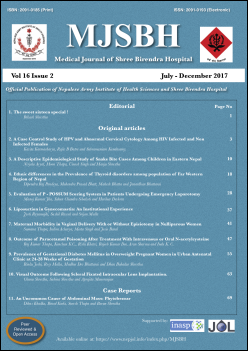A descriptive epidemiological study of snake bite cases among children in Eastern Nepal
Keywords:
children, envenoming, Snake bite, anti-snake venom, neurotoxic,Abstract
Introduction: Snake bite is a significant health issue globally. In Nepal, WHO has estimated more than 20,000 snake bites occurring annually. The prevalence of snake bite in children in Nepal has not been specified yet due to relatively few researches. This study explores the epidemiological data on snake bite among children below 18 years of age from a snake bite treatment center located at Itahari in the eastern part of Nepal.
Methods: This is a descriptive study of the secondary data from treatment records of snake bites among children up to 18 years of age in Samudayek Sarpadansa Upachar Kendra, Itahari, Nepal. The center is located in Army Camp in the eastern plains of Nepal and provides treatment services to all snake bite victims. Recorded data of the patients brought in for treatment in the treatment center from October 2015 to October 2016 were segregated for age group 0 to 18 years and analyzed.
Results: Among 395 cases of snake bite in children below 18 years of age, 57% were boys and most were between 11-15 years. The peak season of bite was during monsoon with clustering of 44% cases from 6 PM to 12 AM and lower limb was the most common site of bite. A total of 7.1% of snake bite cases needed treatment with anti-snake venom.
Conclusion: Snake bite among children below 18 years of age is more common among boys, especially during monsoon and evenings. Only small portion of snake bites require treatment with anti-snake venom.
Downloads
Downloads
Published
How to Cite
Issue
Section
License
This license enables reusers to distribute, remix, adapt, and build upon the material in any medium or format for noncommercial purposes only, and only so long as attribution is given to the creator.




